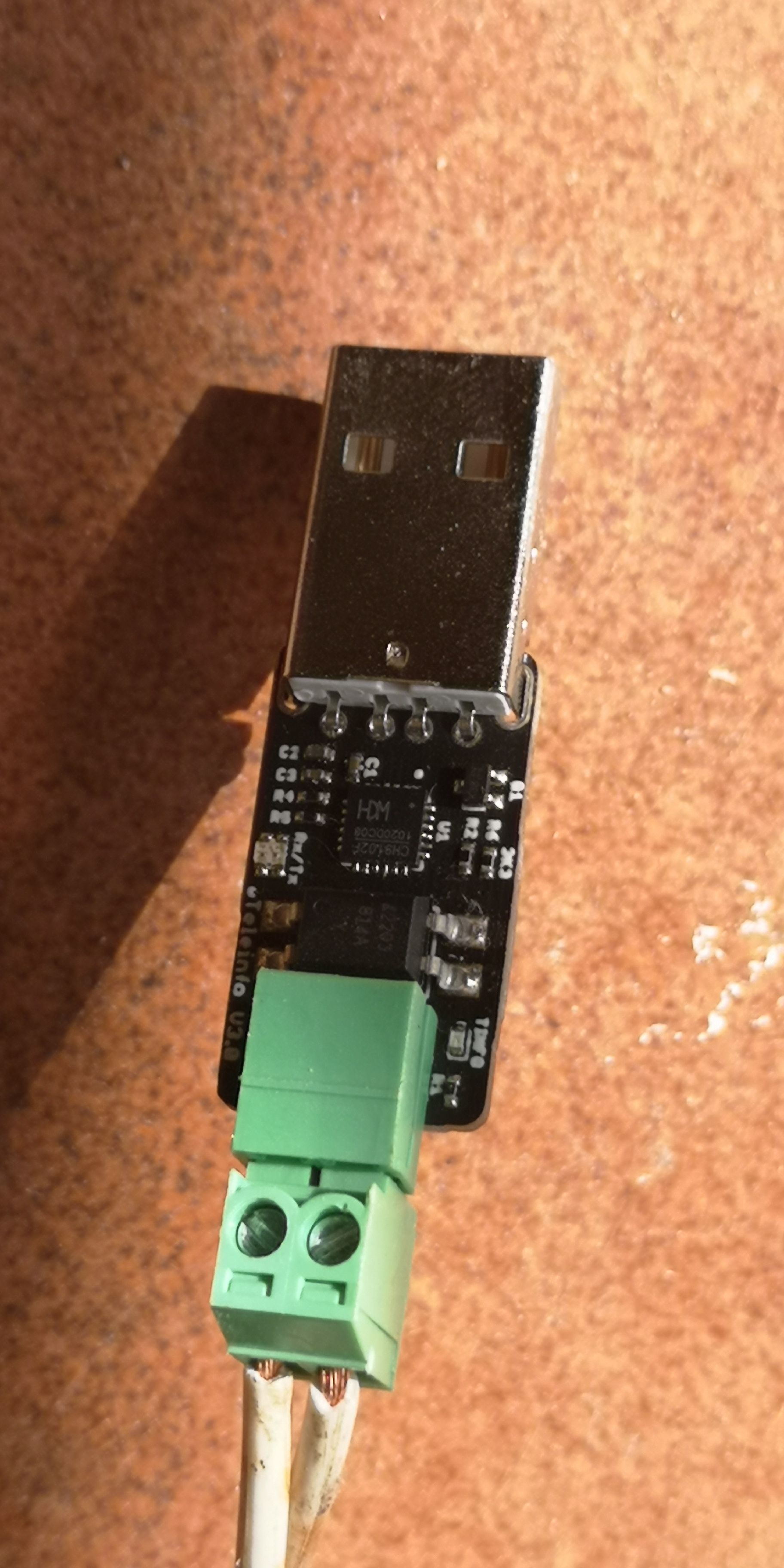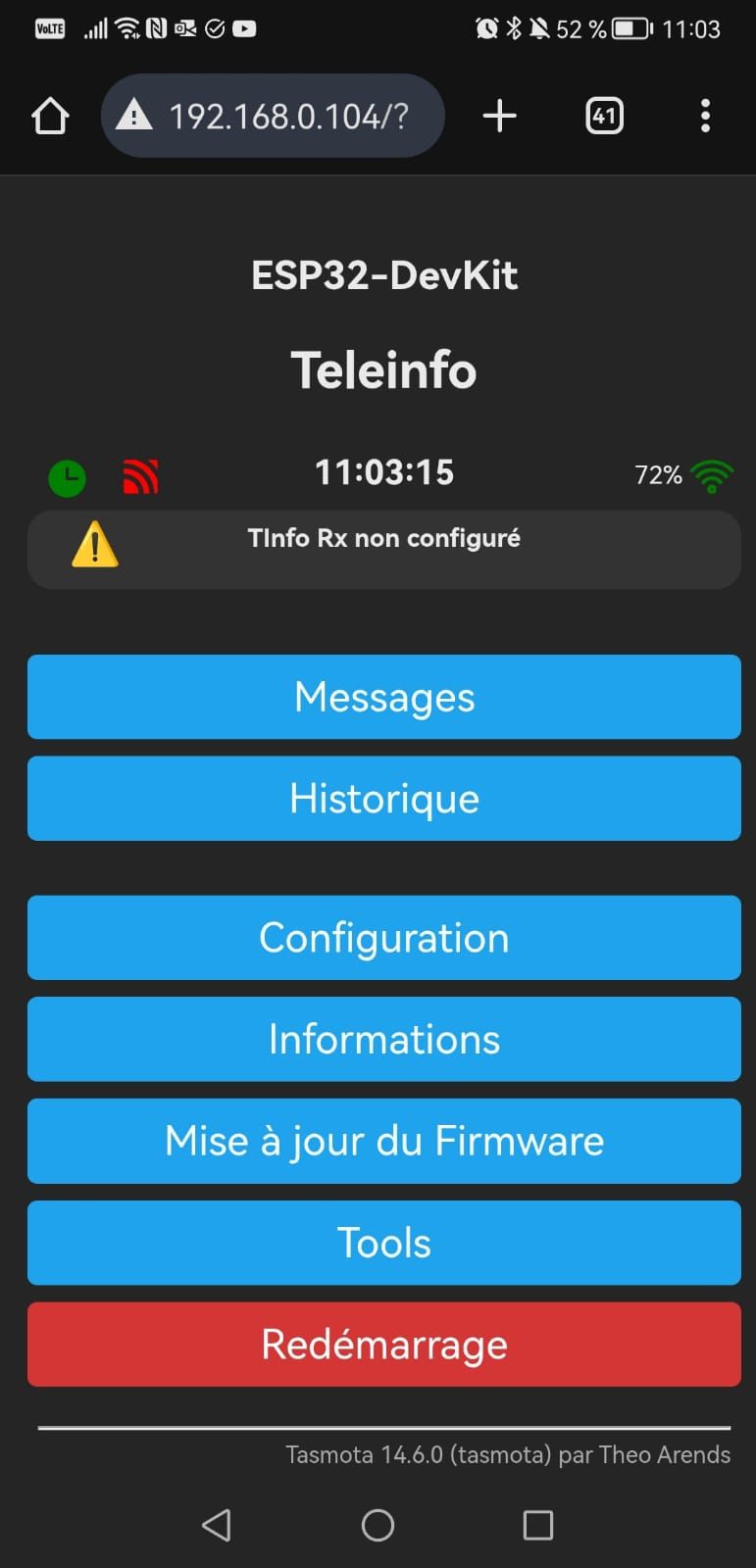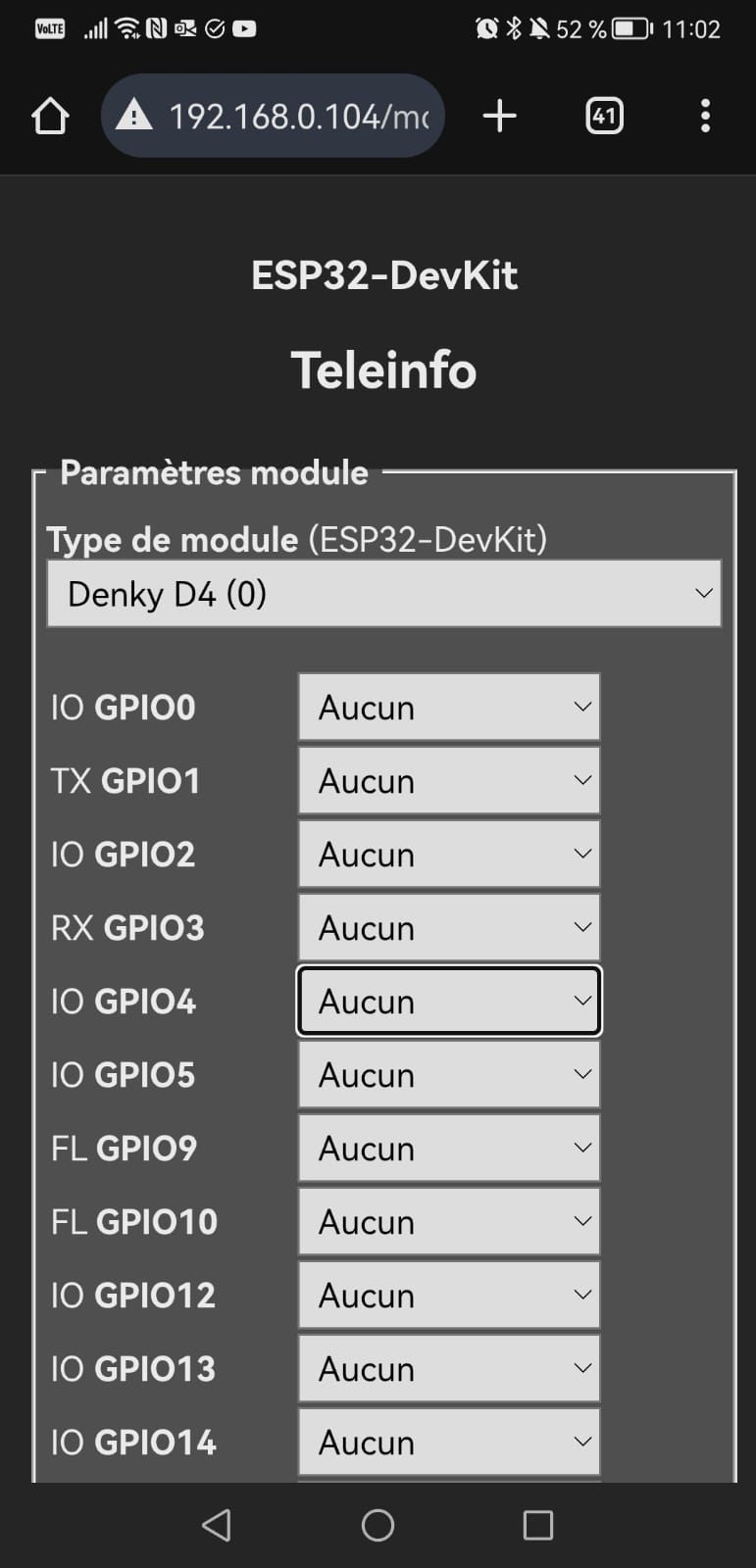téléinfo sur linky Triphasé mode Historique
-
Bonjour,
Après avoir déménagé, je souhaite rebrancher mon installation à base de D1 mini ESP32 et PITInfo. Cette fois, mon linky est en tri-phasé et en mode historique.
N'arrivant pas à obtenir mes résultats, j'ai fait un essai avec IDE Arduino en guise de terminal série (à 1200 bauds) et mon module uTeleinfo connecté à mon port USB mais le résultat me semble déjà à la base discutable :
...
16:15:49.356 -> BB⸮HP⸮B⸮0⸮⸮069963⸮S⸮
16:15:49.543 -> BB⸮H⸮⸮נ000⸮9⸮6⸮9⸮ҍ
16:15:49.777 -> BB⸮HP⸮נ000⸮055⸮9⸮\⸮
16:15:50.008 -> BB⸮H⸮⸮Ҡ000⸮⸮96⸮0⸮Í
16:15:50.194 -> BB⸮HP⸮Ҡ0000⸮3900⸮M⸮
16:15:50.333 -> P⸮⸮àHP⸮B⸮P⸮
16:15:50.474 -> D⸮MA⸮N⸮----⸮"⸮
16:15:50.660 -> ⸮⸮NSԱ⸮000⸮H⸮
16:15:50.800 -> ⸮⸮NSԲ⸮000⸮ɍ
16:15:50.938 -> ⸮⸮NS⸮3⸮000⸮ʍ
16:15:51.078 -> ⸮MAر⸮060⸮6⸮
16:15:51.218 -> ⸮MAز⸮060⸮⸮⸮
16:15:51.359 -> ⸮MA⸮3⸮060⸮⸮⸮
16:15:51.499 -> PMAؠ03530⸮⸮⸮
...Qu'en pensez-vous ? Une piste pour résoudre ce soucis ?
Merci par avance -
@Eric44
Cela ressemble fortement a un problème de résistance sur l'étage d'entrée de l'opto couleur. Si la résistance est variable, essayez de la modifier. -
Merci beaucoup @Nicolas-Bernaerts pour cette proposition mais vu mon niveau en électronique et la miniaturisation de la bête, je ne me vois pas changer une résistance dans le bazar.
Il n'y aurait pas d'autres pistes logicielles ?Pour info, Voici la clé télé info utilisée :

-
@Eric44 said in téléinfo sur linky Triphasé mode Historique:
16:15:50.008 -> BB⸮H⸮⸮Ҡ000⸮⸮96⸮0⸮Í
Normalement le mode historique ne pose pas de soucis de résistance, c'est quel soft qui est flashé dans le D1 ?
-
Bonjour @Charles ,
Le module utilisé était un wemod teleinfo qui fonctionnait très bien connecté au linky de ma précédente maison (monophasé HC/HC). Le code était écrit grâce à ton aide.
En voici le code injecté : teleinfoLinky.txt#include <LibTeleinfo.h> // Parsing JSON #include <ArduinoJson.h> const size_t capacity = JSON_OBJECT_SIZE(4) + JSON_ARRAY_SIZE(4) + 60; String chaineJSONenvoyee; float frequenceInterro=60; String commentairePutWS=""; int PAC = 0; #define SERIAL_DEBUG Serial #define SERIAL_TIC Serial1 // Teleinfo RXD pin is connected to ESP32-PICO-V3-02 GPIO8 #define TIC_RX_PIN 23 _Mode_e tinfo_mode = TINFO_MODE_HISTORIQUE; //_Mode_e tinfo_mode = TINFO_MODE_STANDARD; TInfo tinfo; // Teleinfo object // Wakeup de 5 secondes #define uS_TO_S_FACTOR 1000000ULL /* Conversion factor for micro seconds to seconds */ #define TIME_TO_SLEEP 5 /* Time ESP32 will go to sleep (in seconds) */ #define LEDPIN LED_BUILTIN // Uptime timer boolean tick1sec=0;// one for interrupt, don't mess with unsigned long uptime=0; // save value we can use in sketch even if we're interrupted String sendJSON(ValueList * me, boolean all){ bool firstdatacomplete = true; bool firstdataenvoyee = true; String chaineJSONenvoyee = ""; String chaineJSONcomplete = ""; String Element_Valeur = ""; String separateur = ","; String sep; // Got at least one ? if (me) { PAC = 0; // Json start chaineJSONenvoyee = "{\"commentaire\":" + "\"" + commentairePutWS + "\""; chaineJSONcomplete = "{\"commentaire\":" + "\"" + commentairePutWS + "\""; // Loop thru the node while (me->next) { // go to next node me = me->next; // uniquement sur les nouvelles valeurs ou celles modifiées // sauf si explicitement demandé toutes if ( all || ( me->flags & (TINFO_FLAGS_UPDATED | TINFO_FLAGS_ADDED) ) ) { //Serial.println("|"+String(me->name)+"|") ; /* Serial.print(F("\"")) ; Serial.print(me->name) ; Serial.print(F("\":")) ; */ // we have at least something ? if (me->value && strlen(me->value)) { boolean isNumber = true; uint8_t c; char * p = me->value; // check if value is number while (*p && isNumber) { if ( *p < '0' || *p > '9' ) isNumber = false; p++; } // this will add "" on not number values if (!isNumber) { Element_Valeur = "\"" + String(me->name) + "\":" + "\"" + String(me->value) + "\""; } // this will remove leading zero on numbers else //Serial.print(atol(me->value)); Element_Valeur = "\"" + String(me->name) + "\":" + atol(me->value); } if (String(me->name) != "MSG1" && String(me->name) != "PJOURF+1" && String(me->name) != "ADSC" && String(me->name) != "VTIC" && String(me->name) != "NGTF" && String(me->name) != "LTARF" && String(me->name) != "EAST" && String(me->name) != "EASF01" && String(me->name) != "EASF02" && String(me->name) != "EASF03" && String(me->name) != "EASF04" && String(me->name) != "EASF05" && String(me->name) != "EASF06" && String(me->name) != "EASF07" && String(me->name) != "EASF08" && String(me->name) != "EASF09" && String(me->name) != "EASF10" && String(me->name) != "EASD01" && String(me->name) != "EASD02" && String(me->name) != "EASD03" && String(me->name) != "EASD04" && String(me->name) != "EAIT" && String(me->name) != "ERQ1" && String(me->name) != "ERQ2" && String(me->name) != "ERQ3" && String(me->name) != "ERQ4" && String(me->name) != "IRMS1" && String(me->name) != "URMS1" && String(me->name) != "PREF" && String(me->name) != "PCOUP" && String(me->name) != "PREF" && String(me->name) != "CCASN" && String(me->name) != "CCASN-1" && String(me->name) != "CCAIN" && String(me->name) != "CCAIN-1" && //String(me->name) != "UMOY1" && String(me->name) != "STGE" && String(me->name) != "PRM" && String(me->name) != "RELAIS" && String(me->name) != "NTARF" && String(me->name) != "NJOURF" && String(me->name) != "NJOURF+1" ){ chaineJSONenvoyee = chaineJSONenvoyee + separateur + Element_Valeur; } chaineJSONcomplete = chaineJSONcomplete + separateur + Element_Valeur; } } // Json end //Serial.println(F("}")) ; chaineJSONenvoyee = chaineJSONenvoyee + "}"; chaineJSONcomplete = chaineJSONcomplete + "}"; Serial.println("chaineJSONcomplete = " + chaineJSONcomplete ); Serial.println("chaineJSONenvoyee = " + chaineJSONenvoyee ); return chaineJSONcomplete; } } /* ====================================================================== Function: NewFrame Purpose : callback when we received a complete teleinfo frame Input : linked list pointer on the concerned data Output : - Comments: - ====================================================================== */ void NewFrame(ValueList * me){ SERIAL_DEBUG.println("NewFrame - uptime=" + String(uptime)); if (tick1sec) { concatlog("NewFrame - uptime=" + String(uptime)); chaineJSONenvoyee = sendJSON(me, true); postconsoWS(chaineJSONenvoyee); postlogsindb(); logcycle=""; ledClignotte(); tick1sec = false; } } /* ====================================================================== Function: UpdatedFrame Purpose : callback when we received a complete teleinfo frame Input : linked list pointer on the concerned data Output : - Comments: it's called only if one data in the frame is different than the previous frame ====================================================================== */ void UpdatedFrame(ValueList * me){ SERIAL_DEBUG.println("UpdatedFrame - tick1sec=" + String(tick1sec)); if (tick1sec) { concatlog("UpdatedFrame - uptime=" + String(uptime)); chaineJSONenvoyee = sendJSON(me, true); postconsoWS(chaineJSONenvoyee); postlogsindb(); logcycle=""; ledClignotte(); tick1sec = false; } } /* ====================================================================== Function: initSerial Purpose : Configure (or reconfigure Serial Port) Input : - Output : - Comments: - ====================================================================== */ void initSerial(){ // Cleanup SERIAL_TIC.flush(); SERIAL_TIC.end(); // Configure Teleinfo SERIAL_DEBUG.printf_P(PSTR("TIC RX=GPIO%d Mode:"), TIC_RX_PIN); SERIAL_TIC.begin(tinfo_mode == TINFO_MODE_HISTORIQUE ? 1200 : 9600, SERIAL_7E1, TIC_RX_PIN); if ( tinfo_mode == TINFO_MODE_HISTORIQUE ) { SERIAL_DEBUG.println(F("Historique")); } else { SERIAL_DEBUG.println(F("Standard")); } } /* ====================================================================== Function: ledOff Purpose : Setup I/O for RGB Led to be OFF Input : - Output : - Comments: - ====================================================================== */ void ledClignotte(){ digitalWrite(LED_BUILTIN, HIGH); // turn the LED on (HIGH is the voltage level) delay(1000); // wait for a second digitalWrite(LED_BUILTIN, LOW); // turn the LED off by making the voltage LOW } /* ====================================================================== Function: setup Purpose : Setup I/O and other one time startup stuff Input : - Output : - Comments: - ====================================================================== */ void setup(){ SERIAL_DEBUG.begin(115200); pinMode(LED_BUILTIN, OUTPUT); // Serial, pour le debug SERIAL_DEBUG.println(F("\r\n\r\n")); SERIAL_DEBUG.println(F("=================================================")); SERIAL_DEBUG.println(F(" D1 Mini ESP32 - Teleinfo Lynky Alim WS ")); SERIAL_DEBUG.println(F("=================================================")); SERIAL_DEBUG.println(F("\r\n")); SERIAL_DEBUG.println("[Setup] Gestion du Wifi avec WifiManager"); WifiGestion(); //SERIAL_DEBUG.println("[Setup] Récupération des paramètres de cet arduino : Fréquence d'interrogation et du commentaire de prise de mesure"); //GET_params_arduino(); SERIAL_DEBUG.println("[Setup] Alimentation des logs en BDD à travers le service REST (Requête POST)"); SERIAL_DEBUG.println("-------------------------------------------------------------------------------"); concatlog("[Setup] Alimentation des logs en BDD (Req POST)"); postlogsindb(); // Init Serial Port initSerial(); // Init teleinfo tinfo.init(tinfo_mode); // Attacher les callback dont nous avons besoin // pour cette demo, ADPS et TRAME modifiée tinfo.attachUpdatedFrame(UpdatedFrame); tinfo.attachNewFrame(NewFrame); } /* ====================================================================== Function: loop Purpose : infinite loop main code Input : - Output : - Comments: - ====================================================================== */ void loop() { static char c; static unsigned long previousMillis = 0; static uint8_t buttonState = 0; static unsigned long lastDebounceTime = 0; unsigned long currentMillis = millis(); /* // Avons nous recu un ticker de seconde? if (tick1sec) { tick1sec = false; uptime++; } */ // On a reçu un caractère ? if ( SERIAL_TIC.available() ) { // Le lire c = SERIAL_TIC.read(); // Gérer tinfo.process(c); // L'affcher dans la console if (c==TINFO_STX) { SERIAL_DEBUG.print("<STX>"); } else if (c==TINFO_ETX) { SERIAL_DEBUG.print("<ETX>"); } else if (c==TINFO_HT) { SERIAL_DEBUG.print("<TAB>"); } else { SERIAL_DEBUG.print(c); } } //SERIAL_DEBUG.println("currentMillis=" + String(currentMillis) + "previousMillis=" + String(previousMillis)); if (currentMillis - previousMillis > 60000 ) { SERIAL_DEBUG.println("IL FAUT ENREGISTRER UNE MESURE"); // save the last time you blinked the LED previousMillis = currentMillis; tick1sec = true; } }Suite à la proposition de @Nicolas-Bernaerts, j'ai commandé un Denky D4 1.3a mais ne connaissant pas du tout Tasmota, je me heurte à la configuration. Quel test rapide puis-je faire pour vérifier les valeurs récupérées du flux téléinfo ? (A terme, l'idée est de pouvoir injecter les consos de mes 3 phases toutes les minutes à ma base de données mySql (hébergée par AlwaysData)
-
-
@Nicolas-Bernaerts
Merci pour la référence et désolé pour la réactivité, je suis encore actuellement plus sur le gros œuvre que sur la domotique
J'ai réussi à uploader ton module téléinfo tasmota et m'y connecter. Par contre, il m'affiche l'erreur "TInfo Rx non configuré". En regardant dans les paramètres du module, je n'y vois aucun paramétrage. Peut-être est-ce là qu'il me manque quelque chose ?
Merci par avance de ton retour.


-
@Eric44 si rien n'est configuré c'est normal que cela ne fonctionne pas.
Sélectionnez Denky D4 (0) et appliquez. l'ESP devrait rebooter et être configuré. -
This post is deleted! -
Merci beaucoup @Nicolas-Bernaerts, j'ai à présent accès aux consommations maxi. Par contre, alors que je note le compteur de trames évoluer, ma consommation en temps réel n'est pas alimentée. A quel niveau dois-je agir pour l'afficher ?
-
@Eric44 vous n'avez pas le bouton "courbes" ?
-
@Eric44 pour info après un autoconf la configuration du D4 doit être la suivante

-
J'ai l'impression que tout est opérationnel à présent. Il va me falloir à présent trouver comment alimenter ma base de données avec les puissances soutirées des trois phases. Une idée ?
-
EDIT : J'allais oublier de dire que j'ai une api en post exposée pour intégration à ma bdd.
-
@Eric44 regarde l'exemple en berry de la doc, ça envoi dans une database EMONCMS, mais le principe reste exactement le même.
https://github.com/hallard/Denky-D4?tab=readme-ov-file#send-data-to-emoncms-with-berry
-
Merci beaucoup @Charles je vais essayer cette piste. Cependant, maintenant que la solution Tascoma m'a prouvée que mon téléinfo fonctionnait correctement, je ne comprends pas pourquoi le code que j'utilisais sur mon ancien linky ne fonctionne plus

Est-ce que tu as une piste ? Parce que ce serait beaucoup plus simple pour moi qui ai juste besoin de transmettre dans ma BDD la consommation instantanée toutes les minutes. -
@Eric44 En monophasé et en triphasé les étiquettes teleinfo ne sont pas les mêmes. C'est sans doute pour cela que le soft ne fonctionne plus directement et qu'il nécessite une adaptation.
Concernant la base de donnée, vous avez à disposition un connecteur InfluxDb qui est une base de donnée temporelle très utilisée. -
@Nicolas-Bernaerts j'entends bien que les étiquettes ne sont pas les mêmes mais dans mon code, les callbacks ne sont même pas appelés pour afficher un petit pourront en console.
Quant à la bdd, je l'ai déjà. C'est celle qui gère mes différents objets connectés et sur lesquels je veux agir en fonction de mes panneaux solaires d'où l'interrogation du téléinfo
-
Bonjour,
J'avance dans la solution berry. La fonction appelle bien à fréquence régulière mon API via la fonction send_to_api. Par contre, la règle alimentant mon json ne semble pas être appelée (pour info, j'ai mis un print en tout début de fonction rule_tic et je ne le retrouve pas dans la console). Que me conseillez vous ?
J'ai ce morceau de code dans mon start de autoexec..be :tasmota.add_rule("TIC", rule_tic)Est-ce qu'il y aurait un problème vis à vis de l'évènement TIC ?
PS : Je n'ai rien configuré du côté de MQTT -
Je me permets de revenir sur le forum parce que je sèche complètement. Je ne comprends pas pourquoi ma règle ne s'exécute pas.
Voici mon code simplifié à l'extrème :var post_every = 15000 # Envoi toutes les 15 secondes var variabletest = "vide" def send_to_api() print("variable test:", variabletest) # Pour le débogage dans la console Tasmota tasmota.set_timer(post_every, send_to_api) # Redémarre le minuteur pour le prochain envoi end def rule_tic(value, trigger) variabletest = "TIC" end def start() tasmota.add_rule("TIC", rule_tic) tasmota.set_timer(5000, send_to_api) end tasmota.set_timer(10000, start)Dans la console, suite au redémarrage, je vois ce résultat (avec la ligne réduite des valeurs de mon compteur). Ma variable variabletest (qui semble globale de ce que j'ai lu sur le sujet) n'est jamais alimentée par la valeur "TIC".
18:03:23.535 TIC: Fabricant Sagem / Sagemcom (2019) 18:03:23.536 TIC: Linky triphasé 60A 18:03:26.567 RSL: SENSOR = {"Time":"2025-06-05T18:03:26","METER":{"PH":... 18:03:30.517 variable test: vide 18:03:31.502 RSL: LIVE = {"METER":{"PH... 18:03:33.570 RSL: TIC = {"ADCO":"... 18:03:36.555 RSL: SENSOR = {"Time":"2025-06-05T18:03:36","METER":{"PH"... 18:03:41.577 RSL: LIVE = {"METER":{"PH":... 18:03:43.567 RSL: TIC = {"ADCO":"... 18:03:46.519 variable test: vide 18:03:46.525 RSL: SENSOR = {"Time":"2025-06-05T18:03:46","METER":{"PH":...Quelqu'un peut m'aider ? Je commence à manquer de cheveux pour poursuivre de me les arracher
